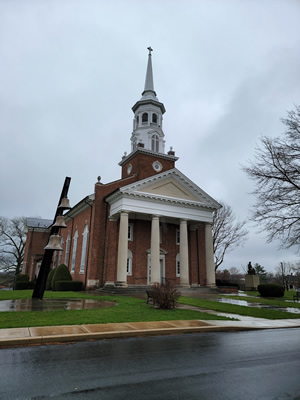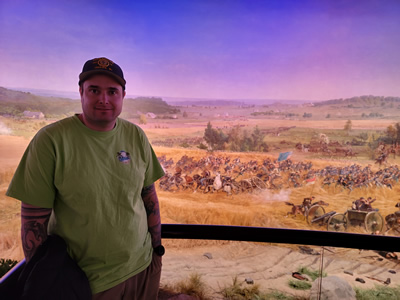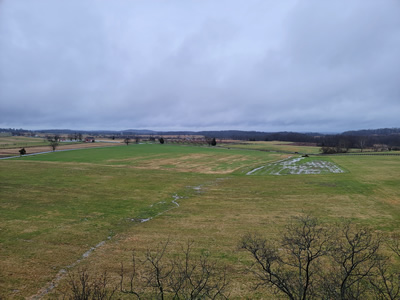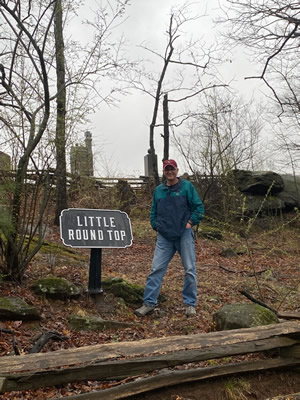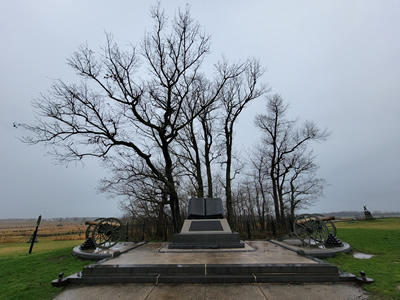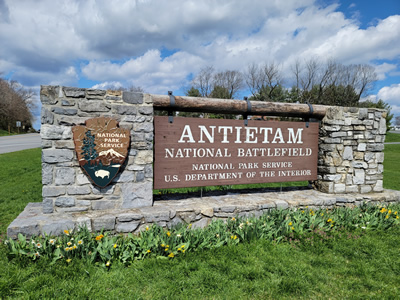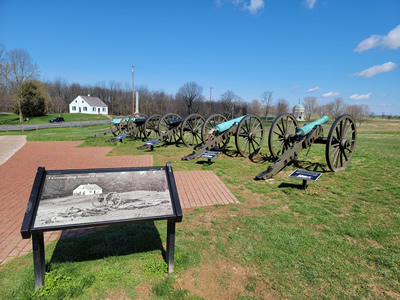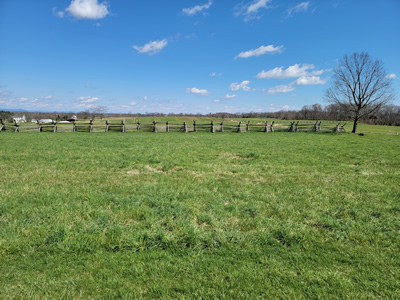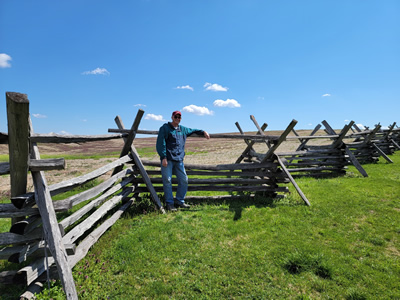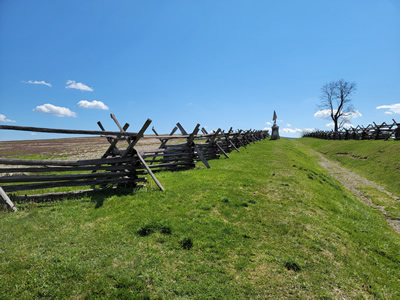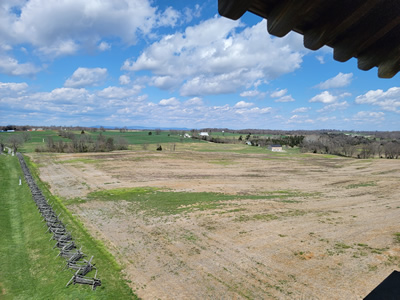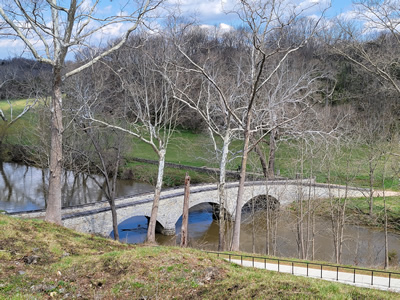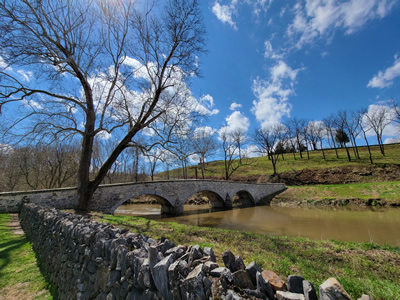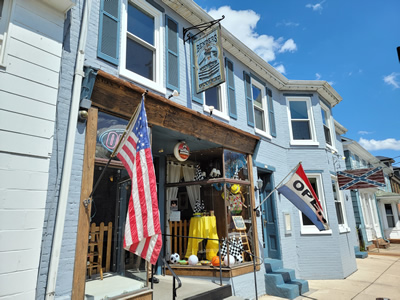Gettysburg And Antietam
I'm my parents' son. My father was an engineer, so I was always interested in science and chose engineering as my profession. My mother was a history teacher and from her I got an interest in history. When combined with my intellectual competitiveness (I played a lot of chess when I was young), it's not surprising that I became a wargamer. That focused my interest on military history. Given that, it's surprising that I rarely visited battlefield sites. Part of it is that I always lived in the Midwest or West and there weren't any close by, but I also never planned trips around historical sites. Until this year the only battlefield site I had ever been to was Yorktown. That was on a trip I made with Sandy when she attended a conference in Virginia Beach in 2014.
That was going to change when I went to the east coast to visit my sons. My youngest son Mickey lived in Baltimore and my oldest son Tim lived in Washington DC (at least he did when I started to plan my trip). There are a lot of Civil War battlefields relatively close by. I knew a little about the Civil War but not nearly as much as other conflicts, so I dove into learning about it. I read a number of books, such as Bruce Catton's Army of the Potomoc trilogy (ok, I only read the first two before my trip but I'm reading the third one now). I read several books on major battles, especial Gettysburg and Antietam. I also got Sandy involved in my research. We watched The Ultimate Civil War Series, a six hour, multipart documentary on the Civil War. We also watched old epic movies like Gods and Generals and Gettysburg. The stories helped to bring the history and the people to life. While not perfect, both movies try hard to be historically accurate. They even try to make the actors look like the real people that they are portraying. During the credits they show an image of the actor in the movie next to an old photo of the character that he played.
We did some wargaming too. We played A House Divided several times. It's a classic strategic level game on the Civil War. A wargame is an excellent way to learn history because it places you in the same situation as leaders at the time. You gain a much greater understanding of the choices that were made when you face the same decisions, with the same opportunities and constraints.
Last but not least, I watched a class from The Great Courses on the Civil War. I thought the lectures were quite good. By the time I left on my trip I knew quite a bit about the Civil War. I felt like I had done my homework and was ready to make the most of my battlefield visits.
My trip was from Wednesday to Wednesday, with both ends being mainly travel days. Mickey and I agreed that we didn't want to visit the battlefield parks, especially Gettysburg, on the weekend. Monday and Tuesday weren't options either. I had planned my trip for when the Milwaukee Brewers were in Baltimore to play the Orioles, and Mickey had tickets for games on both of those days. That left Thursday and Friday, my first full days there. Mickey had taken the whole week off from work to act as host, so he and I were going both of those days. Tim said that he might be able to go Friday if he could get off of work. Since both Tim and Mickey had seen Gettysburg before, we chose Thursday for that and Friday for Antietam.
The forecast for Thursday wasn't great. Sure enough, it was overcast and rainy when Mickey picked me up at my hotel. The drive to Gettysburg took less than an hour and a half so we got there mid morning. Our first stop was at the Visitor Center. We watched a twenty two minute film that provided an introduction to the battle. It covered the background to the Civil War, how the Battle of Gettysburg fit in, and a little about the battle itself. Of course in such a short time, it could only give a very cursory overview. It was ok, but really intended for visitors who don't know anything.
Included on the same ticket as the movie was the Gettysburg Cyclorama. It's a huge circular painting, 377 feet long and 42 feet high, that depicts Pickett's Charge. Visitors stand on a platform in the center and are provided with a detailed 360 degree view. Real objects such as dirt, grass and various battlefield equipment is placed in the foreground to give a 3D effect. Flashing lights and recorded battle sounds give it a multimedia aspect. Cycloramas were popular in the late nineteenth century. They were the entertainment spectaculars of the day. The Gettysburg Cyclorama was painted in 1884 and was acquired by the National Park Service in the late 1940's. It was cool to see as long as we were there (and it was raining outside) but nothing spectacular. Special effects have come a long way in 135 years.
On the way out of the Visitor Center I went through the gift shop. It was quite extensive. Lots of tshirts, caps and books about the battle. I figured I would spend the day thinking about what I might get. Then it was time to move on to the battlefield. We decided to head to Seminary Ridge where the battle had started and go counterclockwise around the battlefield from there.
Since we had to drive through town we stopped for lunch at Tommy's Pizza. We both liked the pizza and I even got a cool tshirt that said "Tommy's Pizza - Gettysburg Pennsylvania".
After lunch we headed out northwest of town and drove around to some of the sights of the first day of the battle. We went by the General Buford monument and the Eternal Light Peace Memorial. We climbed to the top of the Oak Ridge Observation Tower. From there we had an excellent view of the areas fought over on the first day. It was a little scary climbing the metal steps of the tower on a rainy day when they were wet and slippery. We took it slowly and carefully.
Next we drove down Reynolds Avenue to the Reynolds Monument. The immediate area was wooded and it was hard to see much. Then it was on to Seminary Ridge, with a quick stop to photograph the Lutheran Seminary. It looked just like it did in the scenes from the movie Gettysburg. There is a museum inside but we didn't go through it. We continued along Seminary Ridge, stopping at a few spots to get out and look over the field where Pickett's Charge took place. Another climb, this time to the top of the Longstreet Observation Tower, gave the best view.
I had two impressions from this portion of the battlefield. One is that it is a LONG way from Seminary Ridge to where the Union lines were. I couldn't even make out the landmarks in the Union lines from the Confederate starting point. It is easy to understand Longstreet's statement to Lee before the attack.
"General, I have been a soldier all my life...and should know, as well as anyone, what soldiers can do. It is my opinion that no fifteen thousand men ever arranged for battle can take that position."
The other impression I got was that there were too many monuments. Some were useful in marking a notable place, like The Angle, or the spot where Reynolds fell. But there were monuments everywhere - to units, events, individuals, state contingents and everything else you can imagine. Along Confederate Drive on Seminary Ridge, it seemed like there was a statue or marker every fifty feet. I thought it was overdone and cluttered the battlefield. Other people might feel differently.
Next we circled around to the Union side. We went to the top of Little Round Top. I was surprised at how open the slopes looked. Here I didn't think it resembled the terrain as depicted in the movie Gettysburg. We drove by Devil's Den. The ground was as rugged as I had read and looked like a horrible place to fight. But it was also smaller than I had pictured it to be. Finally we ended up at The Angle. It was very powerful to stand there and imagine the events of July 3,1863. That alone was worth the trip.
Because it rained off and on all day we had mainly toured by car. If the weather had been nicer we would have walked more of the field. I still enjoyed the visit and by the time we finished the car tour it was mid afternoon. We stopped in town and at the visitor center for some souvenirs. I got some tshirts and a cap to commemorate the visit to the battlefield, as well as one for Sandy since she had studied the history along with me. Mickey and I were surprised to see how much Trump stuff there was in the souvenir shops. Mickey even texted Sandy and Allie a picture of a "Trump girl" hat and asked them what color they wanted.
Surprisingly, neither of them seemed to appreciate his thoughtful gesture.
Then it was time to head back to Baltimore. We met up with Tim and Allie and went to dinner at Lee's Pint & Shell. It's an oyster bar but fortunately for me they had normal food too. I don't remember much about dinner other than that Tim and our waitress spent the whole evening talking about the gyms where they each went to work out and which gym was better.
The next day we went to Antietam National Battlefield near Sharpsburg Maryland. Tim thought that he would be able to go along but it turned out that he couldn't get away from work that day. The weatherman was more dependable. His forecast for a nice, sunny day seemed to be right on. Mickey picked me up at my hotel again and we headed straight out of town. Just like the day before, it was about an hour and a half drive. Coming in through Boonsboro, we were appoaching the battlefield by the same route as the Army of the Potomac a hundred and sixty years ago.
I had read quite a bit about the battle. That Field of Blood: The Battle of Antietam was a good overview book, with lots of photos of key historical figures and important places on the battlefield. It was similar to an Osprey book (of which I have many). I also read Landscape Turned Red by Stephen Sears, a much more detailed study of the battle. Besides just reading, I also played several wargames on Antietam. As I mentioned above, it's a good way of learning about the battle from a different perspective. I played the Command magazine game Antietam, Burnished Rows of Steel which is an old game but a good one. I had to replace one of the counters in that game because Abby ate a whole Confederate brigade when it fell on the floor. I also played Antietam from White Dog Games. It's a new game that I just got for Christmas from Sandy. I felt like I had a pretty good background on the battle.
In the North it's known as the Battle of Antietam. The Union tended to name battles for major geographical features nearby, usually rivers, so the name was taken from Antietam Creek, which runs along the east side of the battlefield. The Confederates usually referred to battles by the name of the nearest town, so in the South it was known as the Battle of Sharpsburg. Fought on September 17, 1862 it has the sad distinction of being the bloodiest day in American history. The two sides suffered 22,717 killed, wounded and missing. That's more American casualties than D-Day or Pearl Harbor or any other single day in American history. By comparison to the one day of fighting at Antietam, the US suffered 22,370 casualties over the entire twenty years of the war in Afghanistan.
After a major Confederate victory at the Second Battle of Bull Run at the end of August, the Army of Northern Virginia, commanded by Robert E. Lee, invaded the state of Maryland. Previously all battles had been fought in the South, but now the leadership of the Confederacy wanted to take the fight to the North to try to weaken its will to continue the war. The Army of the Potomac, commanded by George McClellan, marched to meet them.
The subordinate units of each army were dispersed across the countryside as they moved. Through a colossal staff error, a copy of Lee's orders were lost and then later found by the Union army. McClellan now had the exact position of every part of Lee's army and where they were to move over the next few days. It gave him the chance to completely destroy the Confederate army in detail and probably end the war. Unfortunately, although he was popular with his troops, McClellan is known to military historians as the ultimate slow and overcautious commander. Literally a joke with wargamers, his nickname of "Little Mac" was even used at one time by a wargame magazine for the name of its annual award for the worst wargame of the year.
Because of the slow movement of the Army of the Potomac, the Confederates had time to realize that their plans had been discovered. The Battle of South Mountain on September 14 further delayed the Union forces enough to allow Lee to consolidate his army. By September 17, the entire Union army was facing most of the Confederate army northeast of the town of Sharpsburg Maryland. With eighty seven thousand Federal troops vs thirty eight thousand Confederates, the Union had a strong advantage. And some of the Confederates were not even on the field yet. AP Hill's division had fought and defeated the Union garrison in Harpers Ferry two days before. They began the seventeen mile march to Sharpsburg at dawn on the seventeenth.
The Confederates did have some things in their favor. They had chosen good defensive terrain and had interior lines. That still probably wouldn't be enough to offset the more than two to one numerical advantage held by the Union. Lee only chose to stay and fight because he knew McClellan well and had little respect for his battlefield command abilities. And Little Mac didn't disappoint him. He committed his troops piecemeal and did not coordinate their attacks. He did nothing to manage the battle as it developed but merely observed from afar. He even held two of his seven corps in reserve the entire day, never commiting them to the battle. Lee was just the opposite. He was in the thick of things, using his interior lines to switch troops from place to place to counter threats, directing them to the critical point of the fighting. Numerous times the Confederate position was on the verge of collapse when reinforcements would arrive at the last possible moment. Finally in the middle of the afternoon one more crisis occured on the Confederate right flank and there were no more reserves anywhere. This was when AP Hill's division arrived after marching seventeen miles and immediatly counterattacked to stabilize the line. The day ended with both armies terribly battered.
Lee eventually withdrew from the field and retreated back into Virginia. The battle had been a tactical draw but a strategic victory for the North. The invasion of Maryland was repelled. But historians also consider it to be a lost opportunity for the Union to destroy the Army of Northern Virginia and end the war quickly. When playing games on Antietam, there are usually special rules to handicap the Union player to make the game interesting rather than always ending in a lopsided Union victory.
Although not a major victory, it was at least a rare non-defeat for the Union in the eastern theater. Lincoln used it as an opportunity to issue the Emmancipation Proclamation. This changed the character of the war to a crusade against slavery and eliminated the possibility of some kind of negotiated settlement that would return things to the way they were before the war had started. It also made it much more difficult for any European powers to intervene on behalf of the Confederacy. This was another major blow to the Confederate cause as a result of the Battle of Antietam.
When we arrived at Antietam, right away it felt different from Gettysburg. Sure, the weather was better, bright and warm and sunny instead of cold and rainy. But it was more than that. When we got to the Visitor Center, we were the only ones there. While we were there, two other people came in. That was it. Much of the time, as we toured the battlefield, we would be by ourselves. Other times there would be two or three other people around. It was very different from the tourist atmosphere at Gettysburg. And while there were a few monuments scattered on the battlefield, it was mostly in a natural state. Great effort had been made to restore many of the features of the battlefield, like the Sunken Road and the Burnside Bridge and the Dunker Church, to their ninteenth century appearance. The landscape looked pretty much as it did on that fateful day in September 1862.
From the Visitor Center we walked over to the Dunker Church. Destroyed in 1921, the building was restored in 1962 for the hundreth anniversary of the battle. The original foundation and as much of the original materials as possible were used in the reconstruction. The church is prominent in a famous photograph taken by Alexander Gardner days after the battle. It shows dead Confederate soldiers with the church in the background. There is a display of period artillery pieces and a print of the famous photograph near the spot it was taken. Standing there looking at the photo and the landscape around it, your mind travels back to when Gardner took the photograph and the grisly scene it shows was real.
From the church we drove to Mansfield Avenue, on the northern edge of the battlefield. This is where the Union attack started at 7am as Hooker's and later Mansfield's corps emerged from the North Woods and attacked Stonewall Jackson's corps. We drove to the center of The Cornfield, one of the few places on the battlefield where there are monuments. Although there were many cornfields on many battlefields, The Cornfield will always be at Antietam. Almost 25,000 soldiers fought over a 24 acre cornfield on the D.R. Miller farm. After two and a half hours, there had been eight thousand casualties there.
After The Cornfield, we moved on to the Sunken Road, also known as Bloody Lane. This was the scene of fighting in the late morning and early afternoon. Again, the lane has been restored as nearly as possible to it's condition in 1862. The only observation tower on the battlefield is here, and Mickey and I climbed to the top for the view. Compared to yesterday at Gettysburg, it was a lot easier climbing and descending the steps in dry weather.
Our last stop was at Burnside Bridge. It's a stone bridge over Antietam Creek where a small Confederate force held off an entire Union corps until well into the afternoon. When the Union forces finally crossed and the Confederate position was about to collapse, it was saved by the arrival of AP Hill's troops that had marched from Harpers Ferry.
Next to the bridge there is a display which features another photograph taken by Alexander Gardner in 1862. It shows a young sycamore tree beside the bridge. That same tree is still there although it is much larger now and towers over the bridge. It was amazing to look at the tree and think that it had been there a hundred and sixty years ago, a witness to the battle.
By the time we finished touring the battlefield it was well past lunch time and time to head into Sharpsburg. The town was quite different from Gettysburg too. No souvenir shops. No restaurants. The only place that served food was Captain Benders Tavern. It reminded me of an old midwestern tavern. There were only two or three other people inside. Lunch was good - I had a sandwich and Mickey had a burger. The lady who was working behind the bar talked to us for quite a while about the area. Not exactly the tourist crunch of Gettysburg.
Outside Benders there was an American flag and a signboard with a Union flag on one side and a Confederate flag on the other. I understand why they would do that right next to a Civil War battlefield but I can imagine that some people would get upset. I don't think that Captain Bender cared though.
After lunch we drove to Harpers Ferry, which took us over half an hour. It gave me a better feel than looking at a map for what it would have been like to march double time all that way just to be thrown into a ferocious battle as soon as you arrived. Man, those guys were tough.
We drove around Harpers Ferry but didn't spend much time there. Still, it was my first time in West Virginia, so I can check that off my list. I also enjoyed seeing the setting of Harpers Ferry. The Confederate attack on the garrison there was an important part of the Maryland campaign and seeing the geography helped me to understand it better.
After that it was time to head back to Baltimore to meet up with Allie and Tim for dinner.
